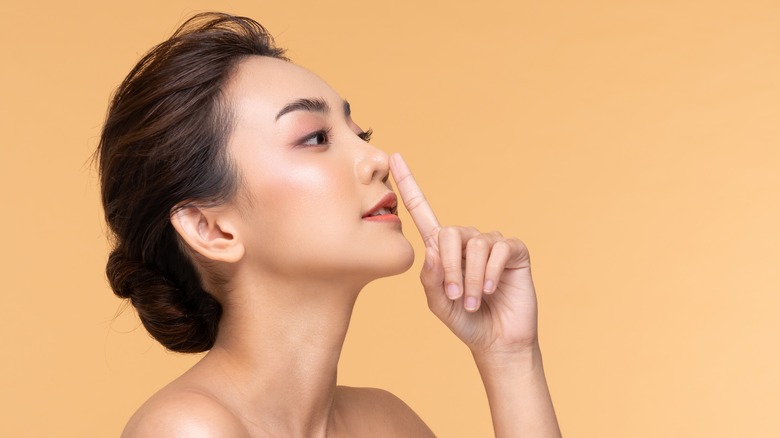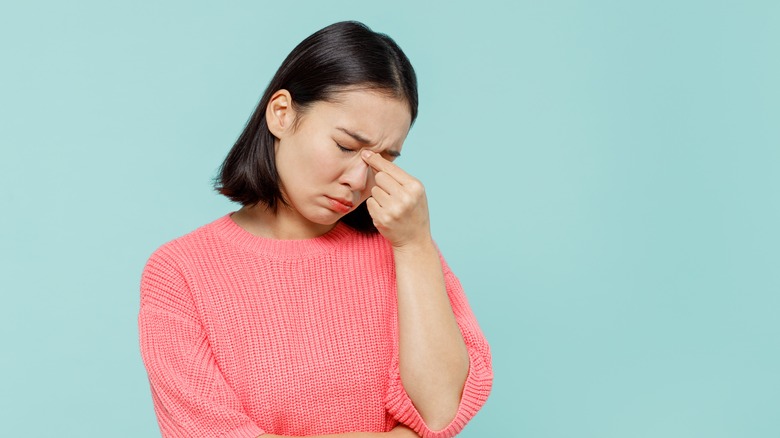How To Reduce The Risk Of Developing A Pimple In Your Nose
The nose is one of the most important parts of the human body. As part of the respiratory system, the nose allows air to enter the body and filters debris to stop harmful particles and allergens (via the Cleveland Clinic). It's safe to say the nose can protect itself. However, it can be prone to various health risks, including internal pimples. According to Medical News Today, pimples in the nose can be irritating, painful, and uncomfortable. Some people may be vulnerable to these pimples more than others.
There are several reasons pimples form in the nose. However, before we dive into them, it's important to understand the anatomy of the nasal cavity in order to help reduce the risk of developing pimples in the nose. Some vital parts of the nose include bone, nasal cavity, septum, nostrils, and sinuses. However, the physiology of the nose isn't complete without the hairs known as cilia, which trap dirt and particles and then move them out of the nose, says the Cleveland clinic.
What puts you at risk for a pimple in your nose
If there's a pimple in your nose, there's a high chance you have blocked pores. According to Healthline, pimples often come when dirt gets trapped in your pores. Bacteria can infiltrate the pores inside your nose and cause infections like nasal vestibulitis and furuncles.
Nasal vestibulitis, also known as folliculitis, can cause redness or inflamed bumps, usually in your nostrils. According to the source, staphylococcus bacteria is a common cause of folliculitis, which normally affects the hair follicle in the skin lining of the nasal vestibule, causing an extremely painful lesion in the nose (per Ancient Science of Life).
Healthline notes that furuncles are boils or deeper infections in the nose. Furuncles are more serious because they can turn into cellulitis allowing infection to enter the bloodstream.
An ingrown hair can also cause a pimple inside your nose. Ingrown hairs can occur naturally in various body areas, and pimples developing at the site of ingrown hairs in the nostril are common, says Medical News Today. According to the source, pimples may disappear without treatment. However, if painful symptoms persist, it's best to consult your doctor.
According to Medical News Today, lupus is an autoimmune condition that can cause sores in the nose. Lupus tricks your immune system into attacking your joints and other organs, including the skin (via the American Academy of Dermatology Association). While you may not expect an autoimmune disease to be behind the pimples in your nose, this might be more common than you think. According to Johns Hopkins Lupus Center, about 25% of people with lupus experience lesions on various body parts, including the nose.
How to treat a pimple in your nose
According to Medical News Today, popping a pimple might increase the risk of infection. Rather, the source recommends applying a warm compress to the inside of your nose until the pimple disappears. They also advise using an antiseptic oil or ointment to prevent infection.
While over-the-counter remedies might help treat pimples in the nose, it's crucial to communicate symptoms to your doctor for an effective diagnosis. Treatment options for pimples in your nose may differ depending on the specific cause. For instance, some doctors recommend antimalarial medications, nonsteroidal anti-inflammatory drugs (NSAIDs), corticosteroids, and immunosuppressive drugs to help manage the symptoms of lupus (via Medical News Today).
Your doctor might also recommend oral antibiotics and topical ointments if the pimple in your nose is nasal vestibulitis (via WebMD). If the pimple persists, it may lead to more critical complications, and to prevent this, your doctor might recommend a surgical procedure to drain the boils in your nose, says WebMD.



